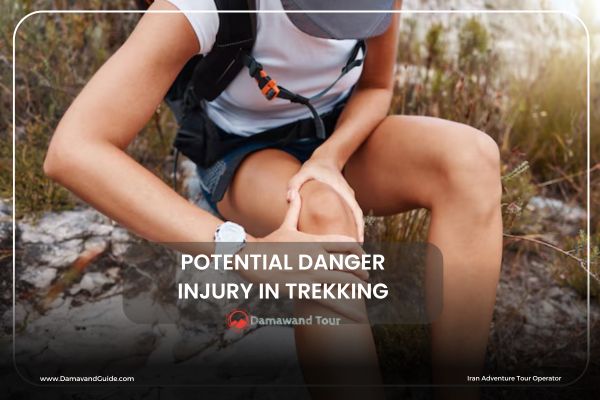
Is Airspace in the Middle East closed?
April 16, 2024
Can Americans Travel To Iran
April 18, 2024Injury in Trekking | Potential Dangers
When you’re hiking in the wild, many unexpected things can happen. It’s tough to get ready for every possible problem. We looked closely at the National Outdoor Leadership School (NOLS) data about hiking injuries to understand the main dangers you might face. This information can help you keep your outdoor adventures safe and enjoyable. Let’s explore the most common injuries in trekking and learn how to prevent them, potentially saving your trip and your life.
Common Hiking Injuries – Prevention & Treatment
Injury in Trekking often begins with the idea of ‘prevention.’ Unfortunately, getting hurt is sometimes part of hiking. That’s why it’s crucial to know both how to stop injuries before they happen and how to take care of them if they do. Despite our best efforts, it’s not always possible to avoid every problem—sometimes, risks and a bit of luck play a role in hiking.
Therefore, it’s a good idea for at least two people in your hiking group to learn some basic first aid before heading outdoors. Make sure your backpack has all the necessary supplies to handle any situation. It’s also essential to recognize different types of injuries and health issues. Knowing how to avoid and handle common hiking problems is just as important.
Here are the “Most Common Hiking Injuries”:
– Blisters
– Sprains
– Cuts
– Hypothermia (getting too cold)
– Hyperthermia (getting too hot)
– Dehydration (not having enough water)
– Sunburn
– Bug Bites
Now, let’s explore each of these injuries. We’ll talk about the best ways to prevent them first and then how to treat them if they occur.
Preventing and Treating Blisters in Trekking
Blisters are a frequent injury that hikers face and happen because your skin rubs against socks or shoes that don’t fit right.
To stop blisters from forming, make sure your socks fit snugly and don’t move up and down as you walk. Your hiking boots should be tight enough to keep your foot from sliding inside them, which causes rubbing. But, they shouldn’t be so tight that they squash your toes. If you like to wear thick socks or two pairs, especially in winter, choose boots with a bit more space. Also, it’s a good idea to wear your boots a few times before a long hike. It’s not wise to buy new boots and immediately go hiking with them.
Keeping your feet dry is also crucial to avoid blisters. Carry two or three extra pairs of socks so you can change them if they get wet, like stepping into a puddle. Also, keep these extra socks dry in your backpack.
How do I treat blisters while hiking?
Sometimes, despite our best efforts, blisters still happen. If you get a blister, it’s important to take care of it fast to reduce pain and stop it from getting worse.
If you have a clean needle, you can carefully make a small hole in the blister to drain it. After draining, clean the area well and cover it with a bandage to keep it from getting infected. It’s not usually a good idea to cut off the skin right away. Remember, you might not have a clean needle while hiking, so don’t pop a blister with anything that isn’t sterilized to avoid infection. Instead, you can use a special blister plaster or tightly wrap the area with a bandage to prevent more irritation from rubbing.
People have different ways they prefer to treat blisters. Some also use these methods to prevent them. For example, you might use moleskin, corn pads, medical tape, duct tape, double socks, wool socks, or even petroleum jelly to help. Petroleum jelly is also great for preventing and treating skin irritation from rubbing during long walks. Lastly, some hikers prefer lighter shoes like trail runners instead of stiff high-lacing boots, especially those who are more experienced and want a more comfortable journey and lighter load on their feet.
Prevention and Treatment of Cuts, One of the Most Common Trekking Injuries
Cuts, while not typically grave, are among the most frequent injuries encountered during hiking. These injuries can occur unexpectedly in various settings and are challenging to completely avoid.
To minimize the risk of cuts, exercise caution on rough terrain to avoid falls, and be vigilant of your surroundings, especially when moving through thick underbrush. This will help you steer clear of potential hazards like branches and brambles that can cause cuts.
How to Treat Cuts While Hiking
For minor cuts, the treatment is straightforward: clean the wound with a disinfectant and secure it with a bandage to protect it from infection and further damage.
Controlling bleeding is crucial in cases of more severe cuts. If the cut is significantly deep, a tourniquet may be necessary. Use an available belt or a spare piece of clothing to tightly wrap the area above the wound. It is essential to note the time when the tourniquet was applied. This information is vital for medical personnel to understand the duration the tourniquet has been in place, ensuring appropriate further medical treatment.

Prevent Injury in Hiking
Dehydration Prevention When Trekking
One key strategy to avoid dehydration during a trek is to drink lots of water. This simple step can help you prevent a common hiking injury.
How do I treat Dehydration?
It’s usually straightforward to spot the signs of dehydration when you’re aware of what to look for. Here are some symptoms:
- Increased thirst beyond the usual.
- Feeling unusually tired or sluggish.
- Urine that appears darker than normal.
- Experiencing headaches.
To manage dehydration, use the same approach as preventing it: drink a lot of water and avoid trekking during the warmest times of the day. A common error is underestimating how dehydrated you are once symptoms start showing. By this point, you might be more dehydrated than you think. It’s wise to pause for a rest in a shaded area and allow your body to absorb the water. However, many continue their hike while trying to drink more water, which can be less effective.
Another method to both treat and prevent dehydration, besides just drinking water, involves using rehydration salts like Dioralyte. This powder mixes essential salts and electrolytes and is crucial for your first aid kit, especially if you’re trekking in summer or hot climates. You could pre-mix some of these into your water bottles. Just remember, some plastic bottles can retain the taste of these powders, which might alter the flavor of plain water added later.
You might also consider adding salt packets (which you can pick up at a restaurant or fast food outlet) to your first aid supplies. If you suspect dehydration during your hike, it’s smart to replenish your body’s salt. Sweating leads to a loss of essential salts from your body. If your body lacks enough salt, it cannot hold onto the water you drink. Consequently, simply drinking a lot of water without also taking salt might just cause you to lose even more salts.
In cases of severe dehydration, it often becomes necessary to seek medical help and possibly receive treatment via an IV for several hours. This shows the importance of taking proactive steps to manage hydration and salt levels to prevent an injury in trekking from becoming a more serious issue.
Read More:
Essential Tips for Climbing Mount Damavand
Iran Travel Guide: All You Need to Know for Iran Exploration
Sunburn Prevention in Trekking
When you’re planning to be outdoors, especially if you’re going trekking, it’s essential to carry sunscreen with a minimum SPF of 25. This helps shield your skin from the harmful effects of the sun. Wearing a sun hat or cap is also crucial in hot, sunny weather to protect your head from direct sunlight. Remember, even on cloudy days, the sun can still cause burns, so always be prepared.
How do I treat Sunburn?
Sunburn is a common and uncomfortable hiking injury.
To soothe sunburn, you can use a cold pack or a damp cloth to cool the affected area. Products like aloe vera can also be applied to the skin to help cool it down and keep it from drying out and peeling. If you’re dealing with this kind of trekking injury, be careful not to burn your shoulders, especially if you need to carry a backpack again soon.
Preventing Hypothermia: Key Steps to Avoid Serious Trekking Injuries
Hypothermia is a severe risk when hiking and is categorized as a critical trekking injury. To ensure safety, it’s important to focus on preventing hypothermia rather than just knowing how to treat it. Hypothermia happens when the body’s core temperature drops too low.
There are several actions you can take to prevent this dangerous hiking injury:
1. Plan Carefully for Your Hike: Choose paths that have sheltered spots for resting instead of stopping in areas exposed to strong winds and harsh weather.
2. Familiarize Yourself with the Trail: Knowing your trail well means you won’t need to stop too often to check your map, which can help keep you warm.
3. Wear the Right Clothes and Gear: Make sure your clothing and equipment are suitable for the weather you expect to encounter.
4. Stay Dry: Keep both yourself and your gear as dry as possible.
5. Pack Waterproof Clothing: Always have an extra set of warm clothes in your backpack that are completely waterproof.
6. Carry an Emergency Shelter: Items like a tarp, a ‘hootchie’ (a simple shelter), or a ‘bivvy’ bag (a compact, lightweight sleeping bag) are essential if you’re trekking through remote areas.
7. Include a Space Blanket in Your First Aid Kit: This is particularly important in cold seasons or in areas known for sudden storms and chilling weather.
8. Bring High-Visibility Items: Have items like a bright vest to make it easier for rescuers to find you in low visibility conditions, which often accompany cold weather.
9. Keep Warm with Drinks and Food: Carry a flask with a warm, sugary drink like hot chocolate and eat regularly to maintain your energy levels.
How to Treat Hypothermia
Recognizing the signs of hypothermia is crucial. Look for the ‘umbles’ – stumbling, mumbling, fumbling, and grumbling – which indicate that someone is beginning to suffer from the cold. A key sign is if the person stops shivering; this means their body is no longer trying to warm itself and is a serious warning.
If you suspect someone has hypothermia:
– Immediately call for help, like mountain rescue.
– Try to dry their clothes if they’re wet.
– Use a survival bag or space blanket to warm them by sharing your body heat.
– Offer a hot drink to help increase their temperature.
– If the person becomes unconscious, it’s vital to warm them quickly as their chances of survival might be only 50-50 at this point.
Taking these precautions and actions can significantly reduce the risk of experiencing a severe injury in trekking related to hypothermia.
Outdoor Activities in Iran | Tips for a Safe Adventure
Outdoor activities in Iran are a great way to explore the country’s natural beauty. Whether you’re planning a trekking tour in Iran or joining a Damavand ski tour guide, it’s important to be prepared for anything. When you’re hiking in the wild, unexpected things can happen, and knowing how to handle them can keep your adventure safe and enjoyable.
Common injuries in trekking include sprains, blisters, and dehydration. To avoid these, make sure you wear proper footwear, stay hydrated, and pace yourself. If you’re new to trekking, consider joining a guided tour. Iran offers many experienced guides who know the terrain well and can help you stay safe.
For winter sports enthusiasts, Damavand is a popular spot. A Damavand ski tour guide can show you the best routes and help you avoid dangers like avalanches. With the right preparation, outdoor activities in Iran can be a fun and memorable experience.




